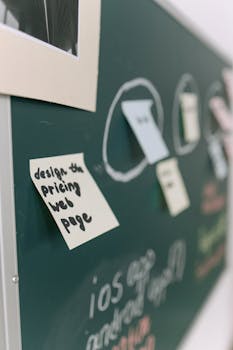Productivity
Best To-Do List Apps for Effortless Daily Organization
Discover the best to-do list apps that simplify daily routines, boost productivity, and keep you organized. Enjoy actionable tips, real-life examples, helpful comparison charts, and friendly advice.
Advertisement
Crossing off tasks can feel as satisfying as ticking off boxes on a grocery list, especially with the right tool. Plenty of people rely on a digital to-do list app to keep their lives in order.
Staying organized means more room for focused work, less forgotten errands, and even fewer mental distractions. A stellar to-do list keeps your thoughts clear, daily priorities visible, and time under control—if you use it right.
Ready to discover which to-do list app fits your needs, habits, and work style? Dive into this deep-dive to compare practical features, real-life examples, and tips for unlocking seamless daily productivity.
Streamlining Every Morning: Setting Up a Time-Saving To-Do List Routine
Setting up a simple ritual with a digital to-do list gives your mornings structure. As you sip coffee, open your app, review today’s agenda, and star one priority you can tackle first.
Selecting a single most-important task helps establish early momentum. Browsing your list, you immediately spot what needs doing—and avoid the “what should I do first?” freeze.
Decide What Gets Added: The Five-Second Rule
As soon as you have a new task, ask yourself: will this take more than five minutes to complete? If so, add it directly to your to-do list without overthinking placement.
People tend to procrastinate by over-categorizing small chores. Adding quickly prevents the task from lingering in your brain and frees you to move on confidently.
If you find yourself hesitating, set a timer. The simple act of writing it down—even imperfectly—keeps your to-do list tidy and reliable all week.
Chunk Work with Labels: “Work Blocks” Technique
Instead of listing items as random bullets, create sections with labels such as “Quick Wins,” “Deep Work,” or “Follow Ups.” Assign tasks based on effort or attention needed, making it easier to plan your day.
This chunking method makes your to-do list resemble a set of clear workspaces. You see at a glance what kind of focus each block demands, so you match the right energy to the right moment.
Whenever energy dips, switch to a Quick Wins block to recapture momentum. By grouping tasks, you also make delegating or sharing lists much faster and cleaner.
| App Name | Platform | Best For | Takeaway |
|---|---|---|---|
| Todoist | iOS, Android, Web | Project Management | Set up recurring tasks for routines and easily filter using labels. |
| Microsoft To Do | iOS, Android, Windows, Web | Personal Planning | Integrates with Outlook; use My Day to focus each morning. |
| TickTick | iOS, Android, Web | Habit Tracking | Create list-based habits alongside calendar tasks to boost consistency. |
| Google Tasks | iOS, Android, Web | Integration with Gmail/Calendar | Add emails as tasks directly to maximize inbox productivity fast. |
| Any.do | iOS, Android, Web | Simplicity Lovers | Voice-add tasks in seconds or use the daily planner for rapid reviews. |
Organizing with Categories: Making To-Do List Apps Fit Real Life Routines
Categorizing to-do list tasks transforms scattered ideas into a logical sequence. Assigning tags like “calls” or “errands” makes it easier to batch work and move through similar items efficiently.
If your brain jumps between topics, categories in your to-do list bring order. You naturally focus on similar tasks together, leading to a sense of smooth progress daily.
Fast Category Building for Immediate Results
Setting up custom categories isn’t just for meticulous planners. Open your to-do list app, tap “create category,” and write the first three that match your week: Family, Work, and Bills, for example.
- Switch to “Work” and finish tasks before lunch, so the afternoon remains flexible for personal items.
- Use “Personal” lists for activities that bring joy to your day, ensuring work and life don’t overlap excessively.
- Batch “Errands” for a specific afternoon, minimizing time spent driving or in stores.
- Set up a “Read/Research” section for continuous learning or creative breaks during busy periods.
- Create “Urgent” lists for surprise deadlines—or pause less critical tasks for later.
People who organize by category find it quicker to get started and almost always remember more details across all their projects.
Leveraging Templates for Recurring Tasks
If you repeat tasks each week, build them into a template. In your to-do list app, duplicate last Monday’s checklist under a new date, ensuring nothing slips past review.
- Draft a weekly template labeled “Housework” to speed up cleaning routines once a week.
- Add a “Weekly Planning” section for reviewing upcoming meetings and setting next steps for goals.
- Save time with checklists for client follow-ups or routine reports; reuse these each cycle.
- Track health or self-care with recurring wellness tasks in a prebuilt list—to stay consistent regardless of busy times.
- Include bill due dates or subscription reminders to prevent late fees month after month.
This approach makes the to-do list feel less like repetitive data entry and more like a tailored support system.
Prioritizing Tasks to Maximize Your Efficiency and Results
You can save hours weekly by ordering your to-do list by impact and urgency. Start each morning by quickly dragging or sorting top tasks to the top of your app.
This tactic helps ensure key assignments get your freshest attention, while lower-energy chores stay visible for when your mental fuel dips.
Ranking Strategies that Actually Stick
People fall into a “busy trap” when their to-do list is ordered randomly. Instead, use a numbered priority system—label the most important task “1,” then move down the list before your day starts.
Say you have five work tasks and three personal ones: assign “1” to the highest-value item, such as preparing a presentation. Tackling this first ensures deadlines don’t sneak up.
Pair this with time blocking. Schedule your #1 item at the start of your day for maximum energy, then tackle lower-priority items as the day progresses. This shifts focus with intention.
Scenarios for Flexible Adaptation
On days where your schedule changes unexpectedly, your digital to-do list shines. Drag tasks up or down to reflect new priorities, or tap to defer when something urgent appears last minute.
Imagine your manager asks for a quick update during lunch. You shift “finish project draft” to tomorrow, mark “send update” as today’s top priority, and move on.
The visual and tactile nature of a to-do list app makes it easy to react to life’s curveballs without losing track of what still needs attention.
Planning Ahead with Smart To-Do List Features for Proactive Organization
Using future reminders and automated dates in your to-do list ensures nothing is missed during a hectic week. Set tasks to repeat monthly, quarterly, or annually, so appointments renew automatically.
Apps with smart suggestions analyze task frequency, nudging you to schedule chores before they become overdue. This frees up cognitive bandwidth and lets you leave preparation to technology.
Integrating Calendars for One-View Scheduling
Connecting your to-do list app to a personal calendar means you see meetings and deadlines together. This birds-eye view protects against overbooking and makes choosing time slots for new work much simpler.
You avoid shock double-bookings by instantly cross-referencing commitments. Color-coded blocks highlight potential conflicts, empowering you to say “that time’s full” with total confidence.
By syncing work meetings and task due dates, you maintain tight control over daily flow, sidestepping late nights and missed appointments with ease.
Delegating Tasks for Team Coordination
Collaborative to-do list apps let you assign chores or projects to colleagues, friends, or family. Assigning items with clear due dates means fewer missed hand-offs.
If you’re working on a group event, add every task—like “order catering” or “book venue”—to a shared list. Tag responsible people directly for easy accountability.
This clear assignment process replaces status meetings, letting teams communicate through checkmarks and comments rather than endless emails or texts.
Checking Progress: Everyday Habits for To-Do List Accountability
Daily progress tracking in your to-do list builds momentum and keeps goals visible. Marking completed items creates a visual record of achievement and motivates continued effort for bigger challenges next time.
Habitual review, ideally before bed, instills reflection. You spot what lagged, celebrate wins, and tweak tomorrow’s priorities in a single 5-minute session, reinforcing continuity across busy weeks.
Using Visual Cues to Reinforce Motivation
Apps showing achievement graphs or checkmarks have a clear psychological impact. Each tick or crossed-off item builds positive reinforcement, making you more likely to come back next day.
Daily streaks, like “7 days of completed tasks,” motivate friendly competition—either solo or among teammates. This gamification approach is especially effective for forming productivity habits.
Reviewing your progress visually translates effort into accomplishment. When you “see” your week in ticks, it’s easier to trust your to-do list system for future goals.
Micro-Reviews for Quick Course Correction
Every few days, pause and scan your to-do list for unfinished items. If a task repeats across several days, it may be too big or lack a clear deadline.
Shrink the item by rewriting: “Write report” becomes “Draft report intro.” Tag with a due date or “review with manager,” making the next step much clearer.
This micro-review step prevents feeling stuck. Rewriting removes hidden blockers and keeps lists actionable, so progress resumes smoothly each week.
Building Long-Term Productivity Habits with Your To-Do List App
Consistent use turns your to-do list from a scratchpad into a true daily companion. Setting a recurring 5-minute morning review makes checking your list second nature, as normal as grabbing coffee or brushing teeth.
Apps with built-in reminders prompt you to look at today’s list at regular intervals. Over time, you develop muscle memory—the urge to check your task list naturally, especially during busy afternoons.
Celebrating Milestones to Maintain Engagement
When you complete a challenging project, pause long enough to savor the crossed-off item or the “all-done” notification. This small act cements the to-do list as a reward system, not just a chore dump.
Take a quick photo of a cleared list at week’s end, or share progress with a friend for added accountability and motivation. These rituals make your productivity journey visible and tangible.
Over time, you’ll associate even intimidating goals with prior wins, transforming big ambitions into a familiar, achievable routine each month.
Upgrading Your System Thoughtfully
If your routine plateaus, experiment with new to-do list features, like subtasks or habit trackers. Explore one feature each month, but only keep what feels intuitive or saves time after a week of real use.
For example, try pinning tasks to your home screen, or testing voice dictation for hands-free capture on busy days. If a feature simplifies your workflow, keep it; otherwise, return to basics without regret.
Adjustment is normal. Your to-do list evolves as your schedule and responsibilities change—stay curious, but always prioritize clarity over novelty for the best long-term results.
Staying Flexible: Adapting Your To-Do List for a Balanced Life
Flexibility is essential for lasting productivity. When life picks up speed, your to-do list shouldn’t become a source of pressure—it should adapt as priorities shift.
Give yourself permission to move tasks forward, postpone less urgent work, or designate “done for today” on incomplete items without guilt. Flexible boundaries guard energy and motivation.
Responding to Unexpected Changes
If an emergency meeting appears, quickly drag important tasks to tomorrow. Label them “priority” to make retrieval quick later. This keeps energy focused on what’s truly urgent now, not lost in overdue clutter.
When family or personal events pop up, pause and return to your to-do list after the interruption. Mark where you left off and resume with clarity, not stress or confusion.
These small adaptations make your list a partner in unpredictable moments, not a rigid scoreboard. Your to-do list helps you stay productive—even as life throws curveballs.
Balancing Ambition with Self-Compassion
Ambitious users sometimes overfill their to-do lists, believing more means better. In practice, selectively dropping non-essential tasks or moving them to “maybe” lists preserves sanity for the long haul.
Learning to leave whitespace, both on your screen and in your calendar, allows space for unplanned creativity and self-care. Treat it as essential maintenance, not wasted time.
If you slip or miss a few days, restart without shame. Your to-do list serves you; it’s not a judge.
Finding Your Perfect Match: Choose a To-Do List App You’ll Return to Every Day
There’s no one-size-fits-all to-do list solution. Explore several top-rated apps using trial weeks: check which design feels welcoming, which reminders fit your habits, and which categories you’ll actually maintain.
The most effective to-do list app is the one you consistently use—one that feels like an assistant, not an obligation. Prioritize features that help you start, sort, and celebrate with ease.
Periodic reviews, smart categories, and quick adaptability set today’s best to-do list apps apart. Commit to five minutes of maintenance daily, and you’ll see tangible improvement in work and life clarity.
Whichever route you choose, remember that the perfect to-do list app isn’t about tech—it’s about habit, intention, and making time for what truly moves you forward.
Trending Topics

How to Improve Sleep Hygiene with Mobile Tools
Strengthen your sleep hygiene with mobile tools that manage bedtime habits and improve nightly rest quality.
Keep Reading
Meditation Timers That Help You Stay Consistent
Stay consistent and mindful with meditation timers that structure sessions, track progress, and promote inner calm.
Keep Reading
Free Workout Planners for Home Fitness Goals
Reach fitness goals faster using free workout planners that personalize exercises and fit perfectly into your schedule.
Keep ReadingYou may also like

Fitness Apps That Turn Small Habits into Long-Term Progress
Stay consistent with fitness apps that transform small daily actions into lasting, measurable health and strength gains.
Keep Reading
